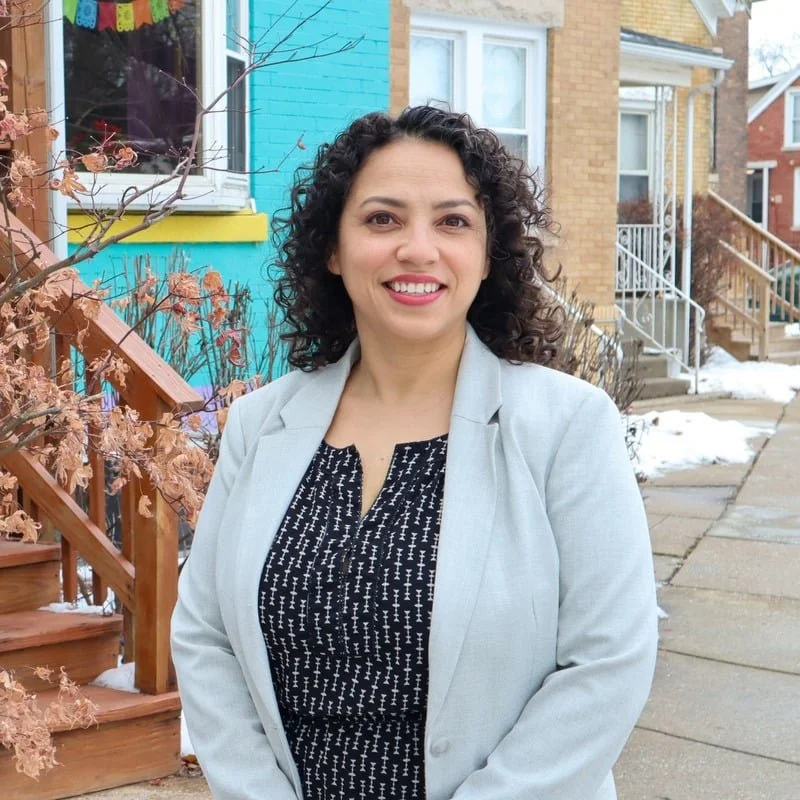We endorse Llilian Jiménez.
Lilian clearly understands the transportation challenges faced in her district and our City, and that it is a critical compontent to addressing climate change.
And, we love that describes herself as an “avid walker!”
Read Lilian’s responses to our questionnaire
What types of transportation do you use during an average week, and how has this shaped your view of transportation policy?
I use my car, Lyft, the bus and the train, and I am an avid walker. Using all types of transportation allows me to see the broader context of structural public transportation deficits in underfunded areas.
What are some transportation challenges in your district?
My district needs more reliable bus service and access to trains. Parts of the Metra and CTA Blue line are in my district, but for the majority of the fourth district population, they are not within walking distance of a CTA or Metra train stop. The CTA needs to be on time, reliable and accessible to encourage Chicagoans to use public transportation instead of driving.
How can the State of Illinois address the impending combined $700 million fiscal cliff facing the CTA, Metra, and Pace in a way that ensures sustained and adequate funding for the future?
The State needs to correct the long held practice of underfunding the CTA, Metra and Pace that have led to a reduction in ridership. We cannot let the fiscal cliff go unaddressed, which would result in dramatically worse service for riders and the halting of needed improvements.
A federal rule allows for states to flex up to 50% of federal highway funds towards transit instead. New Jersey currently flexes 15%, and California flexes 12% compared to Illinois at just under 3%. Would you make any changes to this amount, and if so why?
Yes, I would support this change and increase the percentage to 15% at minimum. Large amounts of federal highway dollars come from gas taxes. It makes sense that a system that taxes the use of gasoline should then reinvest that money in improving more environmentally friendly modes of transportation like trains and buses.
The Illinois Department of Transportation (“IDOT”) plays a significant role in transportation throughout the state and in Chicago. What is your opinion on their relationship with the Chicago Department of Transportation, local communities, and the impact that has?
IDOT needs to collaborate with CDOT and take into consideration the needs of the CTA and the working class people who depend on transportation for their daily needs. I also believe that the CTA workforce needs to create a system to train and recruit employees and subsequently retain them by improving wages and working conditions.
How do you view the Illinois General Assembly’s role in setting IDOT’s priorities for public transit, passenger rail, and strengthening accessibility in transportation?
IDOT’s role is to ensure that Illinoisans can reach their destinations safely, efficiently and cost-effectively. IDOT has a responsibility to build and maintain infrastructure that connects all communities to robust transportation networks. I believe that IDOT needs to prioritize transportation improvements through the lens of climate change and serving low-income communities. New construction needs to consider the impact on the environment and residents of the locations they are building.
What is your position on IDOT’s current proposals for rebuilding North Du Sable Lake Shore Drive?
IDOT needs to prioritize modes of transportation on Lake Shore Drive outside of cars. I would like to see more rapid bus lanes and protected bike lanes. Lake Shore Drive is dangerous, loud and inefficient. If we invest in infrastructure that makes it easier, safer and more cost-effective for working people to get to their jobs and recreational spaces without cars, the environment and the city will benefit. As someone who grew up without access to a car, I believe in policies that work towards zero fatalities and overall pedestrian and biker safety.
